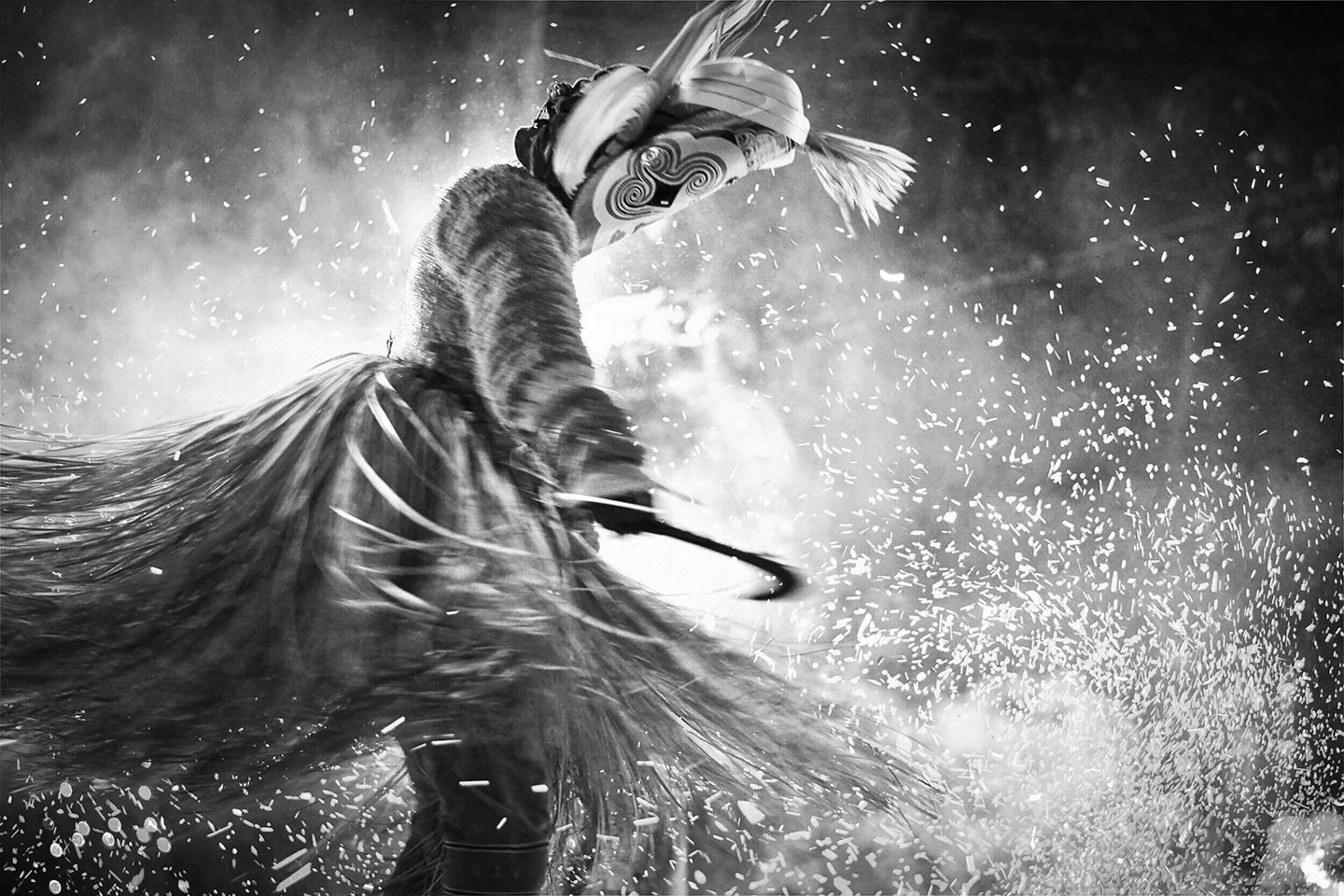I Am Life Entire
Photo by Manyu Varma
In the midst of what can be an awesome fear, and grief, the teachings on death and dying can also be a source of great power, wonder, and love. This talk draws on the work of theologian Hildegard of Bingen on the nature of life and death, and reflections on what it means to know we’ll die as we’re living.
This talk was given by Zuisei Goddard. See below for transcript.
Transcript
This transcript is based on Zuisei's talk notes and may differ slightly from the final talk.
Picture a stormy night, the smell of rain, the peal of thunder. An old woman’s alone in her sitting room which is dimly lit and filled from floor to ceiling with photographs. There’s a wood stove and a fire crackling in it, two bowls next to it for the dog’s kibble and the cat’s milk. One of the lamps in the corner flickers, deepening the shadows on the gramophone’s humongous horn, gold like the rug and the old reading chair the woman sits in, knitting, her needles faintly clicking.
Across from the old woman, whose face is paper maché, lies an old dog, made entirely of yarn. He sighs now and then or raises his head at the thunder. The photographs on the walls, if you look close, are all of the woman and this dog, whose name is Jackson, photos from pup to old hound, young woman to old crone, they’re playing frisbee, going on a picnic, canoeing on a lake, looking adoringly at one another. Two cats, an old female tom and her white kitten walk across the room and Jackson growls at them under his breath. The woman puts a record on the gramophone, and “Autumn Leaves” fills the room. As the piano plays, she sings softly to herself, and the dog joins in, howling in tune.
There’s a knock on the door. Jackson looks up, then looks at the old woman, who continues knitting. There’s a crack of thunder and now, pounding on the door. The rain is coming down harder, Jackson growls, more loudly now, and the old woman, realizing there’s someone at the door, hobbles over to open it. It’s a yellow door, the brightest thing in the house. When it’s opened, framed in it is the Grim Reaper, all dry bones and gray rags, a staff in his hand and a hood covering his naked skull. Jackson growls harder and lets out a bark but the woman shushes him, pointing to the guest. She can’t see well, so she confuses Death with a young Girl Scout whom she invites in to tea, figuring she must be freezing in the pouring rain. Death, a little surprised, follows her in and sits down at the kitchen table, and has tea and the madeleines the woman offers him, while Jackson undoes himself trying to get rid of the unwelcome guest, the protective hound all the way to the end. He grabs a corner of Death’s robe in his mouth, pulls him back, until the woman yells at him—in a very soft, French accent—to stop. He then grabs his leash and brings it to the kitchen, whining to be taken out “You just went out,” the woman says, not taken in for a moment.
Next, a distraction. He follows the cat into the bedroom. The door closes behind them and all hell breaks loose. There’s glass breaking, the cat’s meowing, the sound of a scuffle and when the door opens again, Jackson slinks out, his tail between his legs, and the cat sits licking his paws. Jackson then brings the kitten to Death as an offering, “Don’t take my owner, take this!” Death takes the young cat, sets it on the table next to his tea, and gently strokes him with his skeletal hand. Knowing it’s his last chance, Jackson attacks Death directly, knocking him off the chair and grabbing his staff. He's not going to let go—
But again, the woman scolds him and this time shuts him out of the room. Jackson sits outside looking up at the door knob. He paws the door, crying, his tail drooping sadly. Finally he gives up, goes to his bed and lies down, but not before knocking down one of the photos, which he cradles in his paws. A moment later, the door opens and Jackson rushes to the kitchen. There’s this brief moment when he doesn’t see the old woman and he thinks, “That’s it she’s gone, she’s dead.” But then, there she is, washing tea cups in the sink. Jackson looks at Death, confused, and Death just looks back and then he hunches down, whispers something that only Jackson can hear, and goes… [signal]
Jackson looks into the kitchen and howls once, softly, but the woman doesn’t hear him. She doesn’t see Jackson slowly follow Death out the door. As they’re walking down the lane side by side, the rain stops, the sun comes out from behind the clouds and for a moment, Death’s robe glistens with rainbows. Jackson stops to look back. Death takes from his pocket a bone, throws it far, and Jackson bounds after it, to the sound of “Autumn Leaves.”
It’s late fall, almost the beginning of winter. Death and dying are more apparent during this time, even though it’s inseparable from life. The story I described comes from a video called “Death and the Lady.” If you haven’t seen it, please do. It’s on the New Yorker’s website.
Death, life’s one certainty, its ineluctable end, is, in great part, what got us all here. Perhaps not directly, but think about how different life would be without it. How would you live if you could live forever? Death was one of the four signs, or sights, the Buddha saw when he left his palace—signs he couldn’t ignore, he couldn’t forget, and eventually, simply had to do something about. It’s something all of us have to do something about, sooner or later, even though we’d rather not, not any time soon, and preferably, ever. But then what happens is we are surprised, offended by sickness, old age and death—the surging waves. There is a Vajrayana prayer that goes, “May I liberate all beings from the ocean of existence with its surging waves of birth, aging, illness, and death.” We get surprised, we get offended by these waves, like the man in a retirement home who said, “I was a good father, a good husband. I worked hard all my life. I exercised. Why am I here?” As if someone had broken the contract.
Google owns a company called Calico who’s trying to “solve the problem of death,” but death isn’t a problem to be solved. Neither is life. And yet, it’s not easy to live or die, or, it’s not easy to live or die well. It’s not easy to lose someone either. If you’ve gone through it, you know how interminable the days suddenly feel. You know how hard it is to enjoy even simple things that before delighted you. You look around and wonder how in the world people are still going out to breakfast, talking about the latest political circus, going for walks. You try to tell yourself it’s not so bad and to get over it. People are suffering on the other side of the world so why are you still struggling with this, which is nothing? But no matter what you tell yourself, you just can’t seem to feel yourself. It’s like a film’s been wrapped around you, a layer of cling wrap between you and the world.
Loss, in any form, is hard. The loss of our vitality or our passion, our mobility, our acuity, the loss of people we love, places we know, things that break or get lost. But you know what’s harder? To live as if we get to keep these. To live as if what we have, we’ll always have. That’s much, much harder, because it’s not true. It’s not the way things are. You know one helpful thing to keep in mind? What we still have is never, ever less than what we lack. If we could keep that single equation in mind, we’d be well on our way to freedom, or at the very least, to acceptance, which is a form of freedom. In some ways, Buddhism is a tradition that aims to help us become comfortable with losing … everything. Tibetan Buddhists just say it plainly when it comes to life and death: All of practice is to prepare us for dying.
I have a friend whose 8-year-old son said many years ago, “Mom, the moment we’re born, don’t we start dying?” I hope he hasn’t forgotten this, that in an upside-down way, this is the best part about life—the fact that we die on par with our living. This is what makes life so alive, so flush with itself, so imperative. And because we die as we live, both in each moment and at the end, that means we can die, and live, with grace, with presence, with infinite gratitude and appreciation. Think about it, would you really choose to live on and on? Or would you choose death with your living, loss with your finding? Would you rather choose the risk of being hurt, of having and losing, or not having at all to stay safe and pain-free? I’m not even sure what kind of life that would even be.
I read a story about a woman who finds love when her father is dying. She can’t imagine such loss, and in that moment, she finds something so vast that she could never have imagined it. “Of course,” she thinks, “I have to mark this. I have to make this more permanent, so I’ll ask her to marry me.” The first opportunity is right at her father’s bedside so he can share in their joy, their love. “But,” she thinks, “I can’t. I can’t mix so much joy with so much sorrow.”
The second chance comes when the two women are sick: they’re lying in bed, their sheets sodden with sweat, their eyes crusted over, they’re two big balls of mucus and she thinks to herself, “In sickness and in health, yes, this is how it is,” and decides, “This is it, this is the time to ask.” Then she looks around. Anything short of a trip to the landfill would be a more romantic setting for a proposal, so she holds her tongue.
Third chance, when they’re laying down flooring in their house, a run of the mill day in a run of the mill week. Just as she’s about to ask, her partner tells her a story of a sermon she helped officiate one Ash Wednesday. The young girl, realizing a little belatedly what the day means, hollers at the top of her tiny lungs, “I don’t want to die!” They laugh, she proposes, and they marry, confirming that they’ll go on living, and dying, together.
So, this is what I think: To live dying is to live knowing this isn’t forever. Let’s pause here for a moment and really take this in.
This isn’t forever. (I try to remind myself of this when I’m scrolling through Instagram reels. If this was my last hour, is this how I would spend it?) It’s hard to take in that I won’t be here always, it’s hard to accept. It’s hard to accept that what I have right now I won’t always have, not in this way and, one day, not at all. But what does that loss really entail, where there is no place where we are not?
... I am life entire, which is not struck from stones, nor budded from branches … but all that is rooted is rooted in me… And since all vitality blazes forth from me, I also serve; and I am life eternally the same, without beginning or end.
This is Hildegard of Bingen in The Book of Divine Works. I am life entire, without beginning or end; therefore, I am death entire too. I neither am nor am not, do you see? “To be or not to be, that is not the question,” said Thich Nhat Hanh. To live or to die is not the question either—but then, what is? What is the question? How do we understand all this?
I am the supreme and fiery force who has kindled all sparks of life and breathed forth none of death, and I judge things as they are. Tracing the revolving orbits with Wisdom, I have established true order there. I, the fiery life … blaze above the beauty of the fields, shine in the waters, and burn in the sun, moon, and stars.
As one of you said, “Hot damn, Hildegard! Way to start or end or continue your day.” I, the fiery life, blaze without beginning or end. Death is not end but transformation. If we could remember this, we might not be so afraid of dying. We might not be so afraid of living. Each breath would be the first and the last. There’d be no burden of what if, I should have, I didn’t.
To know that we die as we’re living and we live as we’re dying is to be undone by life in the act of living. To be unraveled by life is to walk down the street as sunlight catches a young girl’s hair, just so, as she, in turn, looks down at a moth that’s landed on her palm and you see this and your breath catches in your throat and you think, “Where have I been all this time? Where have I been that I couldn’t see, couldn’t feel this miracle?” You make a vow not to miss this anymore. Not through distraction and not through sorrow and not through blindness and not through fear because it’s too inconceivable. It’s inconceivable and so are we and not knowing it doesn’t make it any less true. Our delusion doesn’t make our perfection any less true.
Wondrous by Sarah Freligh:
I’m driving home from school when the radio talk
turns to E.B. White, his birthday, and I exit
the here and now of the freeway at rush hour,
travel back into the past, where my mother is reading
to my sister and me the part about Charlotte laying her eggs
and dying, and though this is the fifth time Charlotte
has died, my mother is crying again, and we’re laughing
at her because we know nothing of loss and its sad math,
how every subtraction is exponential, how each grief
multiplies the one preceding it, how the author tried
seventeen times to record the words She died alone
without crying, seventeen takes and a short walk during
which he called himself ridiculous, a grown man crying
for a spider he’d spun out of the silk thread of invention —
wondrous how those words would come back and make
him cry, and, yes, wondrous to hear my mother’s voice
ten years after the day she died — the catch, the rasp,
the gathering up before she could say to us, I’m OK.
It’s a true story, that E.B White couldn’t write Charlotte’s death without breaking down himself. It’s also a true story that when Maureen Stuart was dying with cancer, she gave a dharma talk and said very simply, “I’m not sick.” This really shocked everybody, they thought she’d lost it. Everybody was talking about it, but no one had the courage to talk to her, until finally, someone gathered themselves together and very respectfully said, “Um, teacher, what do you actually mean when you say you’re not sick?” She said, “Oh, I know that I have cancer and that it will kill me within a year, but I'm not sick. This is just what’s happening.” I’m not living, I’m not dying, I’m not worrying about it. This is just what’s happening, this is just. I am life entire, every last, blessed spark:
“All that is rooted is rooted in me… And since all vitality blazes forth from me, I also serve.”
Explore further
01 : Death and the Lady: When the Grim Reaper Knocks by Geoff Bailey
02: Wondrous by Sarah Freligh
03 : Hildegard of Bingen’s Book of Divine Works edited by Maththew Fox


